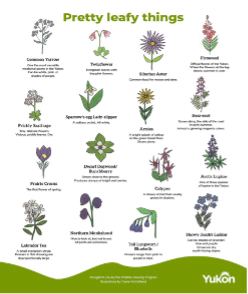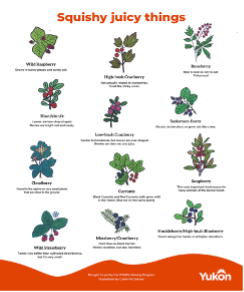July/August 2024 newsletter
Learning through play, outside every day!
Summer in the Yukon is brief and beautiful. It is the perfect time to create thoughtfully designed outdoor spaces for children. Learning through play happens when children can follow their interests in a variety of environments, including outdoors. Outdoor play environments invite children to engage in active play, investigation, independent exploration, and connection to nature.
Spending time outdoors helps children improve their physical and mental health, as well as develop self-confidence and respect for the natural world around them. It is an essential part of a child’s daily routine and supports learning across all domains.
Outdoor play spaces are full of potential. Well-designed outdoor spaces offer experiences to support children’s different developmental processes and abilities. They provide experiences, materials and design components that allow physically active play and quiet activities. They provide spaces for children to play together, as well as to explore individually.
Early childhood educators observe, assess, and improve the outdoor play environment. We create outdoor spaces that inspire children to learn, grow, and thrive.
Outdoor play provides so much joy – for the children, and for you!
Let the children be free; encourage them; let them run outside when it is raining; let them remove their shoes when they find a puddle of water; and when the grass of the meadows is wet with dew, let them run on it and trample it with their bare feet; let them rest peacefully when a tree invites them to sleep beneath its shade; let them shout and laugh when the sun wakes them in the morning.
Maria Montessori, physician, educator and author
Getting started
Ways to bring learning outdoors
The “Outdoor learning everyday” resource guide shares information and resources on the benefits of outdoor learning. It includes lists of developmentally appropriate play materials, as well as ways to provide outdoor learning opportunities that focus on a variety of program areas.
- Music and movement: Dance, run, play musical and active games. Bring instruments outdoors or build your own.
- Blocks and construction: Include materials to build and dig. Provide places, materials, and opportunities for children to build, roll, collect, stack, and explore.
- Cognitive and manipulative: Include materials that allow children to build on their knowledge and problem-solving skills, to make connections and ask questions.
- Dramatic play: Outdoor spaces are ideal for fantasy play and role-playing - include platforms, tunnels, and props.
- Art and creative expression: Bring art materials outside, including paint, clay, and sidewalk chalk.
- Science and nature: Engage in hands-on learning (plant a garden) and exploration (identify trees and plants) to make connections with the world around us.
- Sensory play: Provide experiences for children to engage with colours, textures, sounds and smells. Sandboxes and mud kitchens are a great way to invigorate the senses and provide multi-sensory experiences.
- Language and literacy: Set up a blanket with a basket of books and storytelling props.
Check out this valuable resource online or print and share it with your team!
The following websites provide principles and practices to support educators to bring learning outdoors in their day-to-day routine.
- Outdoor Play Environments (Canadian Child Care Federation) (PDF)
- Bringing the outdoors into early childhood education (Child Care Canada)
- The Seven Cs: information guide to help design outdoor play spaces (University of British Columbia) (PDF)
- Rocking and Rolling. Fresh Air, Fun and Exploration: Why Outdoor Play is Essential for Healthy Development (National Association for the Education of Young Children)
- Outdoor learning environments: best practice principles (Government of South Australia)
Do you know?
The Department of Environment provides colourful and informative printable posters to share
Check out the full collection of “Quick Look” posters. These posters will help you recognize and find a few quick facts about the common plants, animals, and fungi found in the Yukon.
These posters are great for the classroom, and you can laminate them to bring with you on your next outdoor adventure! Consider placing the posters in a basket with magnifying glasses. Hand them out to children and go on a scavenger hunt. The collection includes posters on common Yukon birds, flowers, mushrooms, berries, fish, trees, insects, and mammal tracks.


Not every nature experience must entail a grand adventure to a scenic national park – watching a caterpillar make its way across a sidewalk or simply lying in the grass and watching the clouds go by in the backyard can be a great adventure to a small child.
Linda McGurk, author and educator
Book nook
"Young children with special needs often face physical, emotional, or social barriers to deep engagement with the natural world. These challenges need not prevent them from enjoying the many benefits nature has to offer.
Nature is a necessity. Research tells us that we are happier, healthier, more socially engaged, and more creative when it is part of our daily lives. These benefits apply to people of all ages and abilities.
In this inspiring book, Dr. Ruth Wilson explores the great potential of connecting young children with special needs to the natural world. Drawing on her knowledge of research and her decades of work with children in nature, she weaves together advice, real-life examples, and testimonies from educators and families on the healing, nurturing power of nature in the lives of young children with diverse abilities.” (from the publisher)

Grow
As children engage with the world they delve into inquiries, generate new ideas, solve problems, and build theories of people, places and materials. These engagements can be vibrant, exhilarating and noisy, or they can be quiet, focused, and solitary. Providing time, space, and materials rich with possibilities for experimenting, imagining, and transforming allows children to create and explore in diverse ways based on their interests.
(BC Early Learning Framework, 2019, p. 75)
Consider these reflective questions as they relate to your outdoor learning spaces (p. 77-78):
- Can children engage with materials in ways that are meaningful to them?
- What limits are placed on how children can engage with materials? Who decides the limits?
- What opportunities do children have to access materials that can be transformed or investigated?
- What materials invite experimentation, problem solving, or intrigue?
Explore
Activity idea: Bring loose parts outside
Loose parts spark curiosity, creativity, and imagination. They support children’s development in an inclusive and accessible way. The options for loose parts in an outdoor environment are endless! Here are a few ideas to get you started.
Materials*:
- Kitchen things (pots, pans, bowls, measuring cups, utensils)
- Baskets and buckets (children are natural collectors!)
- Tarps and sheets (include big clips to support the creation of forts, dens, and houses)
- Wheels and sleds (wagons and carts help children move their treasures around)
- Boards (for building, balancing, and bridging)
- Small things (toy cars, dinosaurs, and blocks)
*Remember to consider age and developmental abilities of children when selecting materials.
Learn more from this Outdoor Loose Parts guide
Dig deeper with this professional resource book:
Cultivating Outdoor Classrooms: Designing and Implementing Child-Centered Learning Environments by Eric Nelson

They’re not just playing in nature, they are: learning, creating, sensing, believing, relaxing, exploring, observing, wondering, connecting, discovering, appreciating, understanding, experimenting…
Penny Whitehouse, environmental educator